
Concept explainers
(a)
Interpretation: The relation between P and V as
Concept Introduction:
Due to random movement of gas particles, they colloid with other gas particles and also colloid with wall of container. The collision between gas particles of air and wall of container exert pressure on the wall of container. The gas pressure is inversely proportional to the volume of gas. This is because as the gas pressure increases, the gas particles come close to each other. It decreases the intermolecular distance between particles and volume decreases.
(a)
Answer to Problem 7E
In the given data, the constant value of k proves that:
Explanation of Solution
| Trial | Volume (mL) | Pressure (lb/in2) | Pressure (atm) | ||
| 1 | 60 mL | 10 lb/in2 | |||
| 2 | 40 mL | 15 lb/in2 | |||
| 3 | 30 mL | 20 lb/in2 | |||
| 4 | 15 mL | 40 lb/in2 | |||
| 5 | 10 mL | 60 lb/in2 |
The Boyle’s law states that at constant temperature and amount of gas molecules, the volume is inversely proportional to the pressure of gas.
In the given data, the constant value of k proves that:
(b)
Interpretation: The relation between P and V as
Concept Introduction:
Due to random movement of gas particles, they colloid with other gas particles and also colloid with wall of container. The collision between gas particles of air and wall of container exert pressure on the wall of container. The gas pressure is inversely proportional to the volume of gas. This is because as the gas pressure increases, the gas particles come close to each other. It decreases the intermolecular distance between particles and volume decreases.
(b)
Answer to Problem 7E
In the given data, the constant value of k proves that:
Explanation of Solution
The Boyle’s law states that at constant temperature and amount of gas molecules, the volume is inversely proportional to the pressure of gas.
| Trial | Volume (mL) | Pressure (lb/in2) | Pressure (atm) | |
| 1 | 60 mL | 10 lb/in2 | ||
| 2 | 40 mL | 15 lb/in2 | ||
| 3 | 30 mL | 20 lb/in2 | ||
| 4 | 15 mL | 40 lb/in2 | ||
| 5 | 10 mL | 60 lb/in2 |
(c)
Interpretation: The graph of P versus V needs to be drawn and the relation between gas pressure and volume needs to be explained.
Concept Introduction:
Due to random movement of gas particles, they colloid with other gas particles and also colloid with wall of container. The collision between gas particles of air and wall of container exert pressure on the wall of container. The gas pressure is inversely proportional to the volume of gas. This is because as the gas pressure increases, the gas particles come close to each other. It decreases the intermolecular distance between particles and volume decreases.
(c)
Answer to Problem 7E
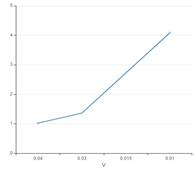
The curve between P and V interprets that with increase in pressure of gas, the volume of gas increases.
Explanation of Solution
The Boyle’s law states that at constant temperature and amount of gas molecules, the volume is inversely proportional to the pressure of gas.
| Trial | Volume (mL) | Pressure (lb/in2) | Pressure (atm) | |
| 1 | 60 mL | 10 lb/in2 | ||
| 2 | 40 mL | 15 lb/in2 | ||
| 3 | 30 mL | 20 lb/in2 | ||
| 4 | 15 mL | 40 lb/in2 | ||
| 5 | 10 mL | 60 lb/in2 |
The curve between P and V must be:
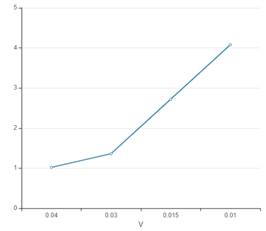
The curve between P and V interprets that with increase in pressure of gas, the volume of gas increases. Overall pressure is inversely proportional to the volume of gas.
(d)
Interpretation: The graph of P versus 1/V needs to be drawn and the relation between gas pressure and volume needs to be explained.
Concept Introduction:
Due to random movement of gas particles, they colloid with other gas particles and also colloid with wall of container. The collision between gas particles of air and wall of container exert pressure on the wall of container. The gas pressure is inversely proportional to the volume of gas. This is because as the gas pressure increases, the gas particles come close to each other. It decreases the intermolecular distance between particles and volume decreases.
(d)
Answer to Problem 7E
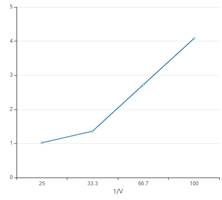
The curve between P and 1/V interprets that pressure is directly proportional to the inverse volume.
Explanation of Solution
| Trial | Volume (mL) | Pressure (lb/in2) | Pressure (atm) | |
| 1 | 60 mL | 10 lb/in2 | ||
| 2 | 40 mL | 15 lb/in2 | ||
| 3 | 30 mL | 20 lb/in2 | ||
| 4 | 15 mL | 40 lb/in2 | ||
| 5 | 10 mL | 60 lb/in2 |
The curve between P and 1/V must be:
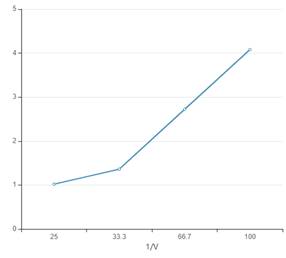
The curve between P and 1/V interprets that pressure is directly proportional to the inverse volume.
(e)
Interpretation: The volume of gas at 30 lb/in2 pressure with the help of given graph needs to be determined.
Concept Introduction:
Due to random movement of gas particles, they colloid with other gas particles and also colloid with wall of container. The collision between gas particles of air and wall of container exert pressure on the wall of container. The gas pressure is inversely proportional to the volume of gas. This is because as the gas pressure increases, the gas particles come close to each other. It decreases the intermolecular distance between particles and volume decreases.
(e)
Answer to Problem 7E
Volume at 30 lb/in2 = 0.020 L = 20.0 mL
Explanation of Solution
| Trial | Volume (mL) | Pressure (lb/in2) | Pressure (atm) |
| 1 | 60 mL | 10 lb/in2 | |
| 2 | 40 mL | 15 lb/in2 | |
| 3 | 30 mL | 20 lb/in2 | |
| 4 | 15 mL | 40 lb/in2 | |
| 5 | 10 mL | 60 lb/in2 |
Convert 30 lb/in2 to atm:
1 atm = 14.7 lb/in2
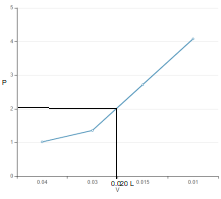
Thus the volume of gas at 2.04 atm will be 20.0 mL.
(f)
Interpretation: The pressure of 50 mL gas with the help of given graph needs to be determined.
Concept Introduction:
Due to random movement of gas particles, they colloid with other gas particles and also colloid with wall of container. The collision between gas particles of air and wall of container exert pressure on the wall of container. The gas pressure is inversely proportional to the volume of gas. This is because as the gas pressure increases, the gas particles come close to each other. It decreases the intermolecular distance between particles and volume decreases.
(f)
Answer to Problem 7E
The pressure of 0.050 L or 50.0 mL of gas must be 0.82 atm.
Explanation of Solution
| Trial | Volume (mL) | Pressure (lb/in2) | Pressure (atm) |
| 1 | 60 mL | 10 lb/in2 | |
| 2 | 40 mL | 15 lb/in2 | |
| 3 | 30 mL | 20 lb/in2 | |
| 4 | 15 mL | 40 lb/in2 | |
| 5 | 10 mL | 60 lb/in2 |
Volume = 50 mL
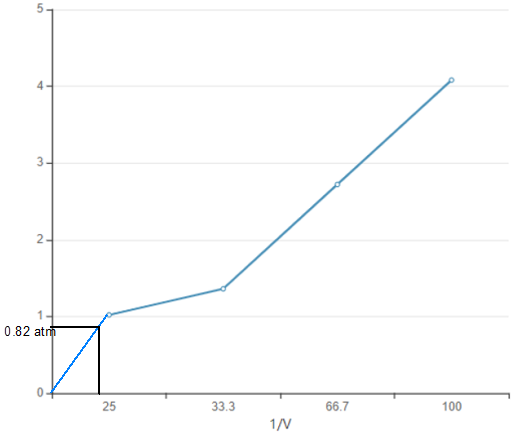
Thus the pressure of 0.050 L or 50.0 mL of gas must be 0.82 atm.
Chapter U3 Solutions
Living by Chemistry
Additional Science Textbook Solutions
Campbell Essential Biology (7th Edition)
Human Physiology: An Integrated Approach (8th Edition)
Organic Chemistry (8th Edition)
Genetic Analysis: An Integrated Approach (3rd Edition)
Chemistry: An Introduction to General, Organic, and Biological Chemistry (13th Edition)
Anatomy & Physiology (6th Edition)
- Choosing reagents and conditions for acetal formation or hydrolysis 0/5 A student proposes the transformation below in one step of an organic synthesis. There may be one or more products missing from the right-hand side, but there are no reagents missing from the left-hand side. There may also be catalysts, small inorganic reagents, and other important reaction conditions missing from the arrow. • Is the student's transformation possible? If not, check the box under the drawing area. If the student's transformation is possible, then complete the reaction by adding any missing products to the right-hand side, and adding required catalysts, inorganic reagents, or other important reaction conditions above and below the arrow. • You do not need to balance the reaction, but be sure every important organic reactant or product is shown. + This transformation can't be done in one step. 5 I H Autumn alo 值 Ar Barrow_forwardA block of copper of mass 2.00kg(cp = 0.3851 .K) and g temperature 0°C is introduced into an insulated container in which there is 1.00molH, O(g) at 100°C and 1.00 2 atm. Note that C P = 4.184. K for liquid water, and g that A H = 2260 for water. vap g Assuming all the steam is condensed to water, and that the pressure remains constant: (a) What will be the final temperature of the system? (b) What is the heat transferred from the water to the copper? (c) What is the entropy change of the water, the copper, and the total system?arrow_forwardIdentify the missing organic reactants in the following reaction: H+ X + Y OH H+ O O Note: This chemical equation only focuses on the important organic molecules in the reaction. Additional inorganic or small-molecule reactants or products (like H₂O) are not shown. In the drawing area below, draw the skeletal ("line") structures of the missing organic reactants X and Y. You may draw the structures in any arrangement that you like, so long as they aren't touching. Explanation Check Click and drag to start drawing a structure. X G 2025 McGraw Hill LLC. All Rights Reserved. Terms of Use | Privacy Cente ? Earrow_forward
- Calculate the solubility of CaF2 in g/L (Kp = 4.0 x 10-8). sparrow_forwardFor the following reaction with excess reagent, predict the product. Be sure your answer accounts for stereochemistry. If multiple stereocenters are formed, be sure to draw all products using appropriate wedges and dashes. 1. EtLi, Et₂O CH₁ ? 2. H₂O*arrow_forwardWrite the systematic name of each organic molecule: structure 요 OH ہو۔ HO OH name X S ☐ ☐arrow_forward
- Predict the major products of this organic reaction. If there aren't any products, because nothing will happen, check the box under the drawing area instead. D ㄖˋ ید H No reaction. + 5 H₂O.* Click and drag to start drawing a structure. OH H₂Oarrow_forwardDraw one product of an elimination reaction between the molecules below. Note: There may be several correct answers. You only need to draw one of them. You do not need to draw any of the side products of the reaction 'O 10 + x 也 HO + 义 Click and drag to start drawing a structure.arrow_forwardWhat are the angles a and b in the actual molecule of which this is a Lewis structure? H- :0: C=N: b Note for advanced students: give the ideal angles, and don't worry about small differences from the ideal that might be caused by the fact that different electron groups may have slightly different sizes. a = 0° b=0 Xarrow_forward
- A student proposes the transformation below in one step of an organic synthesis. There may be one or more products missing from the right-hand side, but there are no reagents missing from the left-hand side. There may also be catalysts, small inorganic reagents, and other important reaction conditions missing from the arrow. • Is the student's transformation possible? If not, check the box under the drawing area. • If the student's transformation is possible, then complete the reaction by adding any missing products to the right-hand side, and adding required catalysts, inorganic reagents, or other important reaction conditions above and below the arrow. • You do not need to balance the reaction, but be sure every important organic reactant or product is shown. + This transformation can't be done in one step. T iarrow_forwardDetermine the structures of the missing organic molecules in the following reaction: H+ O OH H+ + H₂O ☑ ☑ Note: Molecules that share the same letter have the exact same structure. In the drawing area below, draw the skeletal ("line") structure of the missing organic molecule X. Molecule X shows up in multiple steps, but you only have to draw its structure once. Click and drag to start drawing a structure. X § ©arrow_forwardTable 1.1 Stock Standard Solutions Preparation. The amounts shown should be dissolved in 100 mL. Millipore water. Calculate the corresponding anion concentrations based on the actual weights of the reagents. Anion Amount of reagent (g) Anion Concentration (mg/L) 0.1649 Reagent Chloride NaCl Fluoride NaF 0.2210 Bromide NaBr 0.1288 Nitrate NaNO3 0.1371 Nitrite NaNO2 0.1500 Phosphate KH2PO4 0.1433 Sulfate K2SO4 0.1814arrow_forward
 ChemistryChemistryISBN:9781305957404Author:Steven S. Zumdahl, Susan A. Zumdahl, Donald J. DeCostePublisher:Cengage Learning
ChemistryChemistryISBN:9781305957404Author:Steven S. Zumdahl, Susan A. Zumdahl, Donald J. DeCostePublisher:Cengage Learning ChemistryChemistryISBN:9781259911156Author:Raymond Chang Dr., Jason Overby ProfessorPublisher:McGraw-Hill Education
ChemistryChemistryISBN:9781259911156Author:Raymond Chang Dr., Jason Overby ProfessorPublisher:McGraw-Hill Education Principles of Instrumental AnalysisChemistryISBN:9781305577213Author:Douglas A. Skoog, F. James Holler, Stanley R. CrouchPublisher:Cengage Learning
Principles of Instrumental AnalysisChemistryISBN:9781305577213Author:Douglas A. Skoog, F. James Holler, Stanley R. CrouchPublisher:Cengage Learning Organic ChemistryChemistryISBN:9780078021558Author:Janice Gorzynski Smith Dr.Publisher:McGraw-Hill Education
Organic ChemistryChemistryISBN:9780078021558Author:Janice Gorzynski Smith Dr.Publisher:McGraw-Hill Education Chemistry: Principles and ReactionsChemistryISBN:9781305079373Author:William L. Masterton, Cecile N. HurleyPublisher:Cengage Learning
Chemistry: Principles and ReactionsChemistryISBN:9781305079373Author:William L. Masterton, Cecile N. HurleyPublisher:Cengage Learning Elementary Principles of Chemical Processes, Bind...ChemistryISBN:9781118431221Author:Richard M. Felder, Ronald W. Rousseau, Lisa G. BullardPublisher:WILEY
Elementary Principles of Chemical Processes, Bind...ChemistryISBN:9781118431221Author:Richard M. Felder, Ronald W. Rousseau, Lisa G. BullardPublisher:WILEY





